Read this blog post in: Português
Primary education in the territory of Diu during the Portuguese India was divided among Portuguese-speaking schools and Gujarati schools. At the end of the 19th century, and until the sixth decade of the 20th century, there were seven Portuguese schools. Five of which were in the city: in Saint Paul’s former convent, in the Santa Ana shelter, in the convent of Santa Ana (formerly the building of Agiari), in the Escola Primária Oficial Português, and in the Instituto or Externato Liceal Bagvandas Damodar. Another two were outside of the city: one in Vanakbara and the other in Ghoghla, both without facilities of their own.

Saint Paul’s church of Diu, at the centre of the Christian quarter. The church and the old college are in the eastern part of Diu. The former college building, now occupied by various parish programs, leans against the church's north flank. It is a regular quadrilateral articulated by a square cloister, with six sections per side, on the ground floor. The main façade of the school, parallel to that of the church, is separated from it by the space occupied by the stairs that give access to the upper floor of the cloister. Primary education for males took place on the ground floor of Saint Paul’s former convent. The college was run by the Jesuits.
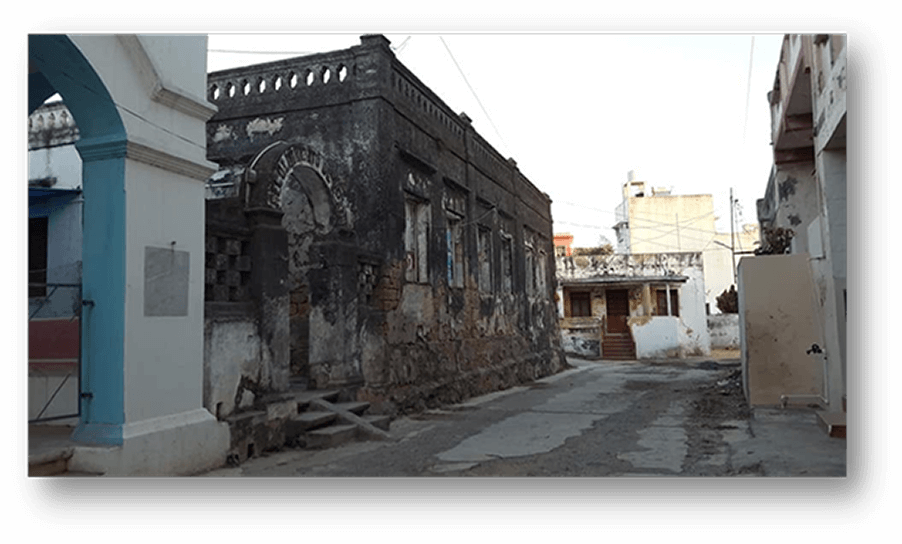
The front view of the Santa Ana shelter, in the Christian quarter. Primary education for females was on the ground floor. Nuns gave classes in art and decoration, such as embroidery and flower arrangement. Photo courtesy Shreeman Vijay Cumaldas.

The side view of the Santa Ana shelter, in the Christian quarter. Photo courtesy Shreeman Vijay Cumaldas.

Gateway to the former Agiari building in Parsiwada. The last Zoroastrian families are said to have left the island of Diu in about 1950, but the survival of the fabric of the fire temple for over half a century without much alteration is mainly a result of the decision made by the last members of the community. The sacred element in a fire temple is, of course, the fire which should be kept alive at all times. Should a community leave an area the fire should be taken away but the building itself has no sanctity. When in 1950 the sacred fire was to be taken to Surat, the Zoroastrians made their wishes known to the Portuguese Governor of Diu and on the recommendation of Archbishop D. José Alvernaz a group of nuns from the order of the Handmaids of Christ were sent from Calangute, Goa, to occupy the building and set up a convent there. The building, now St. Anne’s Convent, is a centre for the island’s community and also has a successful infants’ school. Photo courtesy Shreeman Kaushal Parekh.

Santa Ana Convent, in the former Agiari in Parsiwada, where the pre-primary school currently operates. Photo courtesy Shreeman Vijay Cumuldas.
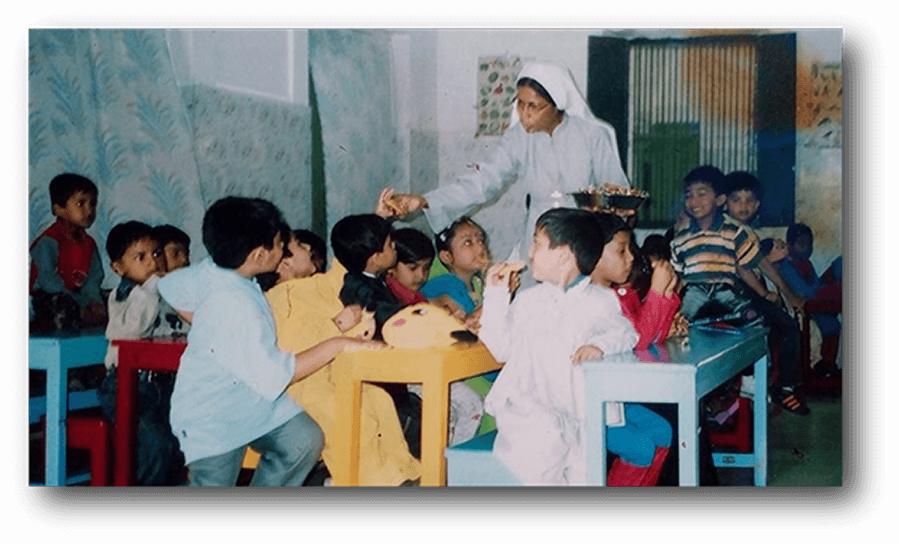
Former building of Agiari, today Santa Ana Convent, where the pre-primary school currently operates. Photo courtesy Shreeman Vijay Cumaldas.
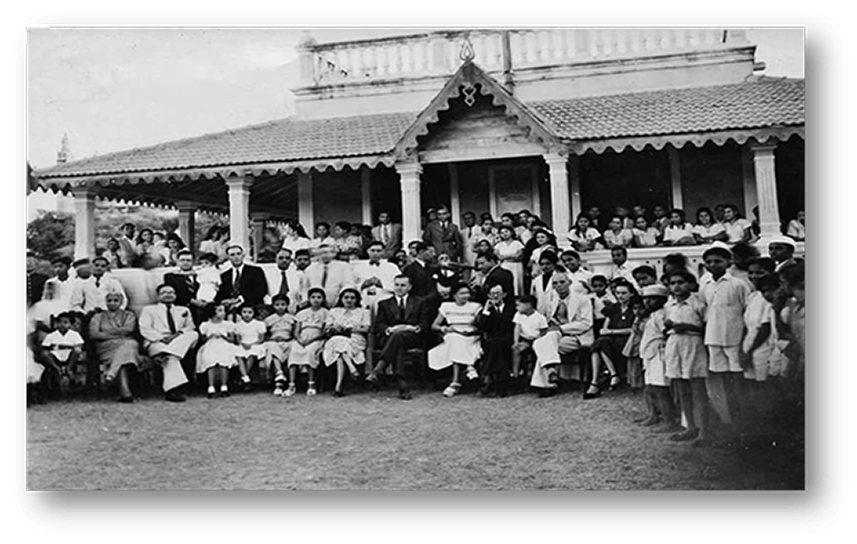
The Portuguese Primary School in the Christian quarter. It is assumed that this photograph, by Mr. Shantilal Shivshankar Bhatt, was taken on November 11, 1949, the day of the celebration of the Portuguese conquest of Diu. This celebration was attended by the distinguished presence of the Governor of Diu, D. Miguel de Noronha de Paiva Couceiro, dignitaries from the city of Diu, teachers, students and auxiliary staff of the school. In this school, the Portuguese language was taught until the 4th grade. Some of the teachers from the school were: The Reverend Father José de Souza, Prof. Melita de Pereira, Prof. Maria Noémia Borges Vaz, Shri Ramnikrai Devshankar Pandya, Prof. Luís? Gill and Prof. Elsa Coutinho.
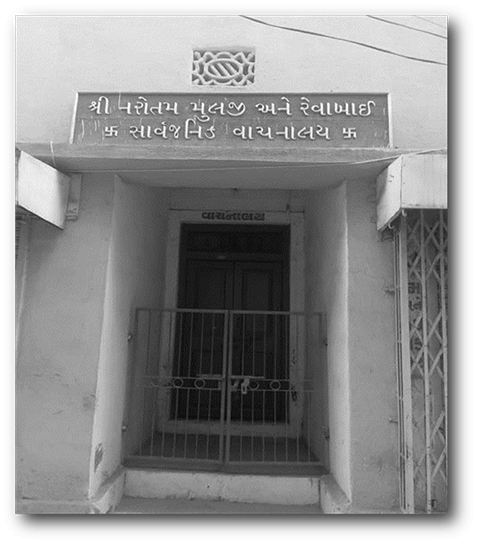
The Externato Bagvandas Damodar, initially installed on the first floor of the Narotam Mulji & Revanbai Library. Photo courtesy Shreeman Kaushal Parekh.

The building adjacent to Apasaro where Portuguese classes were held. The Externato Bagvandas Damodar, initially installed on the first floor of the Narotam Mulji & Revanbai Library, was relocated to Apasaro's new facilities in Cuxalpara. Photo courtesy Shreeman Vijay Cumaldas.
As non-Catholics were more affluent and made up the majority of Diu’s population (about 98% in 1899), the Gujarati schools took on architectural importance. Three constructions of this type stand out, all in the city of Diu.
The first structure, the Royal Portuguese-Gujarati School, was built in 1895 on the initiative of Probudás Virchande, a merchant in Mozambique, and is located about 250 metres southwest of the Customs Market. It is a building of modest dimensions which reflects the British administration’s bungalows on the Indian subcontinent. A porticoed veranda wraps the building. Its sober features and the importance given to openings and ventilation reveal the care given to hygiene at the time. It is still used as a teaching institution.

The Royal Portuguese-Gujarati School, built in 1895, at the initiative of Shree Prabhudas Virchande. At this school, Shree Ramnikrai Devshankar Pandya taught the Gujarati language. He also taught Portuguese to the 6th and 7th grades from 4pm. Photo courtesy Shreeman Kaushal Parekh.
The second school opened in 1927 and was for girls. It was named after its founder, Pani Bai, the wife of Bhagvandas Laxmichand, whose name appears above the main entrance. It is located about 400 metres west of Diu’s Saint Paul’s Church and may have resulted from the conversion of an older structure. The building is shaped like an elongated rectangle and has two floors. The main façade is arranged in sections separated by pilasters; the central part stands out, with the main access on the ground floor and the projecting veranda on the upper floor. This veranda was subject to intervention in 2008. Around the entrance are various examples of decorative motifs and relief work painted in bright colours. The rest of the façade is marked by arched windows; they are likewise decorated with sculptures and figurative reliefs referring to the Hindu culture. The volume is topped by a balustrade, a common element in most Diu buildings.

Panibai school for girls. Unfortunately, this building was demolished a few years ago. Photo courtesy Vijay Cumaldas.
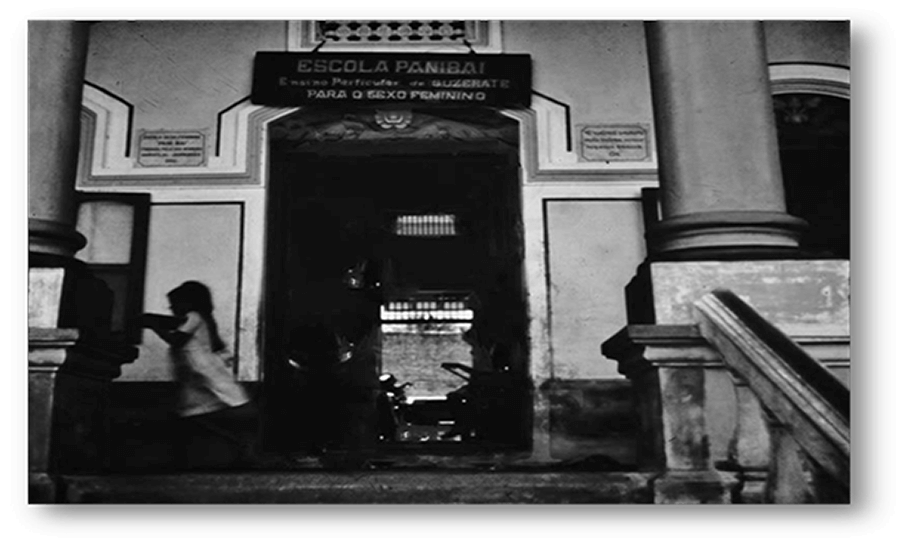
Panibai school for girls. In this school, primary education was from the 1st to the 4th grade. The teachers at this school were: Shreemati Jiviba (?) (Headmistress), Shreemati Savitaben Lauchand, Shreemati Triveniben Morar, Shreemati Hiraben K. Solanki, Shreemati Mayaben ?, Shreemati Matuben Girdhar Ruda, Shreemati Prasutaben Girdhar Ruda, Shreemati Induben Prabhashankar and Shreemati Taraben Ramshankar, among others. Photo courtesy Shreeman Vijay Cumaldas.

Panibai school for girls, during an embroidery class. In this photograph, we can see, seated in the front row from left to right,?, Hasumatiben Ramchand,?, Vasantiben Tribovandas and Jasumatiben Motichand, and standing by the door, Indiraben Tulcidas. The teacher, Mrs. Maria Helena Magalhães Filipe, taught embroidery classes. Her daughter, Miss Maria Manuela Carreira de Magalhães Filipe, taught traditional Portuguese music. These classes were hugely successful.
The third building was built around 1931 and is also associated with the philanthropic action of Pani Bai, and is therefore also called by that name. The main gate bears the name of Amratlal Jamnadás, the probable benefactor of the construction. It is situated about 250 metres east of the main gate of the city’s walled line. The rectangular building is set back from the street by a small garden opened by a colonnade. The roof is flat and finished by a balustrade. The façades are profusely decorated, even the structural elements, which include geometric and vegetal motifs of Indian origin.

Panibai school for boys. In this school, primary education was from the 1st to the 7th grade. The teachers at this school were: Shree Shivshankar Bhatt, Shree Dayalal Jani, Shree Natvarlal Himatram, Shree Dalpatram Nagji (who resigned from his position in 1954), Shree Virgiri Laxmangiri Goswami, Shree Harkishandas Laldas Yoganand, Shree Shambhugiri Laxmangiri Goswami, Shree Ravishankar ?, Shree Maneklal Himatram Vyas, Shree Santilal V. Pandya, Shree Vasantlal Shah and Shree Prabhashankar Jani among others. This school remained in operation after the liberation of Diu in 1961. Photo courtesy Shreeman Kaushal Parekh.

Panibai school for boys. View from the inside. Photo courtesy Shreeman Vijay Cumaldas.
The school in Vanakbara operated in a government building provided by the council.
There was another school, the Official Portuguese-Gujarati Primary School, in Ghoghla, where Portuguese was taught until the 2nd grade in a cubicle rented for that purpose, and Gujarati was taught until the 7th grade. After the 2nd grade, students from Ghoghla studied Portuguese at the Escola Primária Oficial Português in Diu.
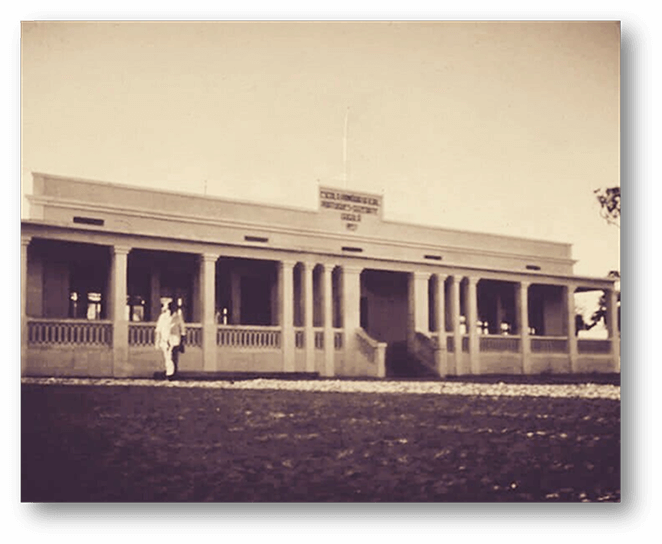
The Official Portuguese-Gujarati Primary School in Ghoghla. In 1959, Mrs. Saryuben Shantilal, wife of Mr. Pravinchandra H. Dave, joined as a teacher at this school. In 1961, as a principal, she was awarded by the Portuguese government for her good service provided to the school.
Post by Dipac Canacsinh
Acknowledgements
I want to thank my friends Kaushal Parekh and Vijay Cumaldas, who provided the photographs for this article.
My gratitude goes also to my friend, Kaushal Parekh, who was extremely helpful in offering invaluable assistance and support. The interview with Shreeman Lalitchandra Prabhashankar Joshi, led by Shreeman Kaushal Parekh, revealed to us quite interesting information regarding the beginning of primary education in Diu. Scroll to the end of the article in order to listen to this interview.
A very special thank you to Shree Hasmucrai Amarchande, Shreemati Saryuben P. Dave, Shree António Anil, Mrs. Zulema Figueiredo, Shreemati Mradula Virgiri Goswami, Shree Vishvesh Virgiri Goswami, Mrs. Milva Maggioni, Shreemati Savitaben Lauchand, Shree Gulabchand Kibabhai Mali and Shree Ravindrarai Shantilal Pandya, for the key information they provided me with for this article. I would also like to quote their student life experiences in Diu during the Portuguese rule:
Shree Hasmucrai Amarchande, popularly known as Babu Kaka, who is a kind collaborator for my various articles and currently resides in the United Kingdom, recalls the days of his childhood in Diu during the Portuguese regime. In his words:
I attended Panibai school and Escola Primária Oficial Português where I studied Portuguese until I attended high school at Externato Bagvandas Damodar when the liberation of Diu took place. One of the teachers who taught at Externato Bagvandas Damodar was Prof. Alberto Furtado Luz. Shri Ramnikrai Devshankar Pandya taught Gujarati classes at the Royal Português-Gujarati School. I attended his Portuguese classes in the 6th and 7th grade, which were taught after 4pm. I worked at the Civil Registry office of Diu for many years.
I remember with great nostalgia and emotion the days I spent as a student at Escola Primária Oficial Português. I keep in regular contact with my former colleagues, whom I remember very fondly. The teachers that taught at Externato Bagvandas Damodar when I was a student included Prof. (?) Morgaokar, Prof. Edmundo De Costa and Prof. (?) Salpico among others. My respected grandfather, Shree Shivshankar Bhatt, was a teacher at the Panibai school for boys. My dear and respected father, Shri Shantilal Shivshankar Bhatt, was a photographer, known as Shantilal Photographer. In 1959, I was a teacher at the Portuguese-Gujarati Primary School in Ghoghla. In 1961, as a principal, I received honours from the Portuguese Government for the good services I had provided to the school. My husband, also a renowned teacher and headmaster, retired from the Government High School Diu. My sister, Shreemati Niranjana S. Bhatt, popularly known as Niruben, who has already retired, was also a teacher. My brother, Shreeman Nilkamal S. Bhatt continues to be a teacher.
I was a student at Escola Primária Oficial Português. When I moved to Apasaro for my first year of high school, teaching was interrupted by the Indian conquest of the Portuguese territory. After a few years, I resumed my studies at the Panibai school for boys in Gujarati. Later, I continued my studies at Government High School Diu. I worked in the Public Works Department, PWD, of Diu.
Zulema Figueiredo was born in Diu to a Christian family. She currently lives in Coimbra, Portugal. Here is what she said:
I was a student at Escola Primária Oficial Português. Some of the teachers from the school were: Prof. Maria Noémia Borges Vaz, Shri Ramnikrai Devshankar Pandya, Prof. Luis Gill and Prof. Elsa Coutinho. I have vivid memories of my childhood in Diu. At the Santa Ana shelter, the nuns gave classes in art and decoration, such as sewing, embroidery, flower arrangement, etc. I left India in February 1961, months before the liberation of Diu.
I was a student at Panibai school for girls. I remember very well the teachers who taught Gujarati at this school. Teaching was up to the 4th grade. As an adult, between June 1972 and May 1975, I was an English, Gujarati, Hindi and Science teacher at the Bhagvandas Laxmichand Vidhyalay.
My father was a teacher at the Panibai school for boys. He was born to teach. I remember him always busy with school tasks. My uncle, Shree Shambhugiri Goswami, was also a teacher at Panibai school. There were also Portuguese schools in Fudam, Nagoa and Bucharwada.
My grandmother, Prof. Maria Helena Magalhães Filipe, taught embroidery at Panibai school for girls. My mother, Prof. Maria Manuela de Carreira Magalhães Filipe, taught traditional Portuguese music. These classes were hugely successful.
Shreemati Savitaben Lauchand, married to Shreeman Tribovane Narcim, taught Gujarati classes in Diu during Portuguese India. I had great pleasure in talking to her and here is what she revealed to me:
I taught Gujarati at the Panibai school for girls in the fifties. The other teachers who were also teaching at that time included Jiviba (?) who was Headmistress, Triveniben Morar, Hiraben K. Solanki and Matuben (?), among others.
Two of the teachers at Panibai school for boys were Shree Dayalal Jani and Shree Natvarlal Himatram.
There was a Portuguese School, Escola Primária Oficial Português, which was located in the Christian quarter where the Child Development Project Office (CDPO) currently exists. At this Portuguese school, classes up to the 4th grade were taught. Some of the teachers who were a part of this school were: Reverend Father José de Souza and Prof. Melita de Pereira. At the Instituto Liceal Bagvandas Damodar, education was made up of two cycles. The 1st cycle consisted of two years and the 2nd cycle consisted of three years. There was no teaching for the 3rd cycle in Diu. Students wishing to continue their studies for the 3rd cycle would have to travel to Panaji, Goa. After passing the 3rd cycle consisting of two years, students could opt for higher education. The teachers who were a part of this school were: the Honourable Judge Edmundo De Costa who taught French, the military officers who taught Portuguese, Mathematics and Science and the Police Chief, Bernardo De Sousa who taught English. There was also a Portuguese-Gujarati school in each of Diu, Ghoghla and Vanakbara. The school in Diu was located about two hundred and fifty metres southwest of the Mercado da Alfândega. Teaching at this school was from the 1st to the 4th grade and Shree Ramnikrai Devshankar Pandya taught the language of Gujarati. The other, in Ghoghla, the Escola Primária Portuguese-Gujarati Oficial, where Portuguese was taught until the 2nd grade, operated in a cubicle rented for that purpose. The teacher was Shri Santilal Venishankar Pandya. The third school, in Vanakbara, operated in a government building given to the council. Teaching at this school was from the 1st to the 4th grade. The teacher was Shri Vajeshankar Revashankar Joshi. In 1960, a few teachers were selected to teach primary education: Shri Jivabhai Bhikhabhai Vaishya, Shri Bhikhabhai Bhagvan, Shri Panchabhai Govind, Shri Harjibhai Kahan and Shri Nanubhai A. Modasiya, among others.
I also cannot fail to thank Shree Dr. Hasmuklal Mulchande and Shree Champaclal Mulchande for having provided me with the contact of Mrs. Zulema Figueiredo, with whom I had great pleasure in talking to about her experiences in Diu. Thanks also to Shree Tanesh Shambhugiri Goswami for putting me in contact with his cousins, Shreeman Vishvesh Virgiri Goswami and Shreemati Mradula Virgiri Goswami.
A heartfelt thanks also to Shree Paresh Dhirajlal Chudasama for contacting Shree Ravindrarai Shantilal Pandya who provided me with a brief history of the schools in Diu and the names of a few of the teachers who provided their services in those schools. I am also grateful to Shree Satendra Mulchande and Shreemati Malti Tribovane for providing me with the contact of Shreemati Savitaben Tribovane.
Finally, I would like to thank Shreeman Paresh Mugatlal and Shreeman Hemal Canacrai for helping me on the search for the full names of some teachers who taught at the Panibai school for girls, and my friend, Chandraskekhar Canacsim, for identifying the person in a photograph.

